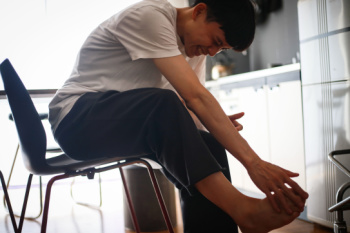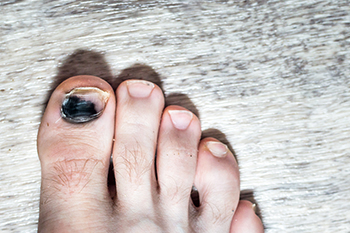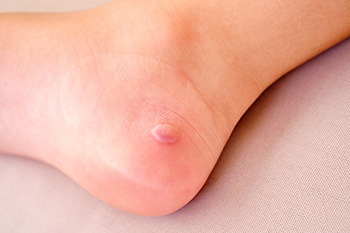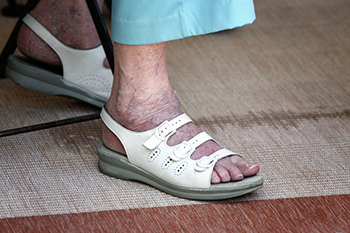Glen Allen Office
(804) 747-3380

Gout is a type of inflammatory arthritis that can cause intense pain and discomfort, often affecting the heel. This condition arises when uric acid levels in the blood become elevated, leading to the formation of sharp crystals in the joints. Symptoms of gout in the heel typically include sudden, severe pain, swelling, and redness in the affected area. The pain may be most intense during the night or early morning, making it difficult to walk or put weight on the heel. Several factors can contribute to the development of gout, including a diet high in purines found in red meats, shellfish, and alcoholic beverages. Other risk factors include obesity, certain medical conditions, and genetic predisposition. If you have heel pain, it is suggested that you consult a podiatrist who can accurately diagnose gout in the heel, and offer you effective relief and treatment solutions.
Gout is a painful condition that can be treated. If you are seeking treatment, contact one of our podiatrists from The Podiatry Center. Our doctors will treat your foot and ankle needs.
What Is Gout?
Gout is a form of arthritis that is characterized by sudden, severe attacks of pain, redness, and tenderness in the joints. The condition usually affects the joint at the base of the big toe. A gout attack can occur at any random time, such as the middle of the night while you are asleep.
Symptoms
Risk Factors
Prior to visiting your podiatrist to receive treatment for gout, there are a few things you should do beforehand. If you have gout you should write down your symptoms--including when they started and how often you experience them, important medical information you may have, and any questions you may have. Writing down these three things will help your podiatrist in assessing your specific situation so that he or she may provide the best route of treatment for you.
If you have any questions, please feel free to contact one of our offices located in Richmond and Glen Allen, VA . We offer the newest diagnostic and treatment technologies for all your foot care needs.

Ankle sprains are common injuries in volleyball, often occurring during jumps or quick lateral movements. These sprains are classified into three grades, each reflecting the severity of the injury. A Grade 1 sprain involves mild stretching of the ligaments, typically resulting in minor pain and swelling, with recovery usually taking a few days to a week. A Grade 2 sprain indicates a partial tear of the ligaments, causing moderate pain and swelling, often requiring two to four weeks for healing. A Grade 3 sprain represents a complete tear, leading to severe pain and instability, and may take six weeks or more to recover. Stopping the activity, avoiding putting weight on the foot, and wrapping the ankle to reduce swelling may help to bring relief. If you enjoy playing volleyball, and have sustained an ankle sprain, it is suggested that you promptly schedule an appointment with a podiatrist who can guide you toward specific treatment solutions.
Ankle and foot injuries are common among athletes and in many sports. They can be caused by several problems and may be potentially serious. If you are feeling pain or think you were injured in a sporting event or when exercising, consult with one of our podiatrists from The Podiatry Center. Our doctors will assess your condition and provide you with quality foot and ankle treatment.
Common Injuries
The most common injuries that occur in sporting activities include:
Symptoms
Symptoms vary depending upon the injury and in some cases, there may be no symptoms at all. However, in most cases, some form of symptom is experienced. Pain, aching, burning, bruising, tenderness, tightness or stiffness, sensation loss, difficulty moving, and swelling are the most common symptoms.
Treatment
Just as symptoms vary depending upon the injury, so do treatment options. A common treatment method is known as the RICE method. This method involves rest, applying ice, compression and elevating the afflicted foot or ankle. If the injury appears to be more serious, surgery might be required, such as arthroscopic or reconstructive surgery. Lastly, rehabilitation or therapy might be needed to gain full functionality in the afflicted area. Any discomfort experienced by an athlete must be evaluated by a licensed, reputable medical professional.
If you have any questions, please feel free to contact one of our offices located in Richmond and Glen Allen, VA . We offer the newest diagnostic and treatment technologies for all your foot care needs.

Runner's toe is a condition commonly experienced by runners and those who walk frequently. It occurs when repetitive trauma causes blood to collect beneath the toenail. It results in a blackened nail, known as a subungual hematoma. Wearing tight shoes and constant pressure on the toes during such exercise can lead to this issue. Symptoms of runner's toe include nail discoloration, pain, and occasionally, the nail separating from the nail bed. While a black toenail may heal on its own, it can sometimes lead to complications, such as infection or thickening of the nail. A podiatrist can assess the severity of the blackened toenail and suggest pain relief medication. This foot doctor will also check for underlying issues, such as fungal infections or circulatory problems that may contribute to the condition. If you are a runner with a toenail that has turned black, it is suggested that you visit a podiatrist for an exam and treatment.
Exercising your feet regularly with the proper foot wear is a great way to prevent injuries. If you have any concerns about your feet, contact one of our podiatrists of The Podiatry Center. Our doctors will treat your foot and ankle needs.
How to Prevent Running Injuries
Many common running injuries are caused by overuse and overtraining. When the back of the kneecap starts wearing out and starts causing pain in your knee, this is commonly referred to as runner’s knee. Runner’s knee is a decrease in strength in your quadriceps and can occur if you’re not wearing properly fitted or supporting shoes. To prevent runner’s knee, focusing on hip strengthening is a good idea, as well as strengthening your quads to keep the kneecaps aligned.
What Are Some Causes of Running Injuries?
- One cause of a common running injury is called iliotibial band syndrome.
- Plantar fasciitis is also another common injury.
- Stress fractures can occur from overtraining, lack of calcium, or even your running style.
Best Ways to Prevent Running Injuries
- Wear footwear that fits properly and suits your running needs.
- Running shoes are the only protective gear that runners have to safeguard them from injury.
- Make a training schedule. Adding strengthening exercises as well as regular stretching can help keep you strong and limber and can lessen the possibility of injuries.
- Stretching keeps muscles limber; this will help you gain better flexibility.
If you have any questions please feel free to contact one of our offices located in Richmond and Glen Allen, VA . We offer the newest diagnostic and treatment technologies for all your foot and ankle needs.

Falls in the workplace can lead to a range of foot injuries, including bruises and contusions, cuts, sprains, and strains. To prevent such accidents, it is essential to maintain a clutter-free environment and ensure that floors are clean and dry. Proper lighting in all areas can help avoid trips and falls, and non-slip mats should be used in high-risk zones. Employees should also be encouraged to use handrails on stairs and to wear appropriate shoes that provide good traction. Regular safety training and awareness programs are critical for reinforcing these practices. Falling in the workplace can impact the feet and may cause loss of wages. If you have injured your feet from falling, it is suggested that you consult a podiatrist who can treat various foot conditions and get you back to work.
Preventing falls among the elderly is very important. If you are older and have fallen or fear that you are prone to falling, consult with one of our podiatrists from The Podiatry Center. Our doctors will assess your condition and provide you with quality advice and care.
Every 11 seconds, an elderly American is being treated in an emergency room for a fall related injury. Falls are the leading cause of head and hip injuries for those 65 and older. Due to decreases in strength, balance, senses, and lack of awareness, elderly persons are very susceptible to falling. Thankfully, there are a number of things older persons can do to prevent falls.
How to Prevent Falls
Some effective methods that older persons can do to prevent falls include:
Falling can be a traumatic and embarrassing experience for elderly persons; this can make them less willing to leave the house, and less willing to talk to someone about their fears of falling. Doing such things, however, will increase the likelihood of tripping or losing one’s balance. Knowing the causes of falling and how to prevent them is the best way to mitigate the risk of serious injury.
If you have any questions, please feel free to contact one of our offices located in Richmond and Glen Allen, VA . We offer the newest diagnostic and treatment technologies for all your foot care needs.

A friction blister on the foot is a small, fluid-filled bubble that forms on the skin due to repeated friction or rubbing. This common condition typically occurs in areas where the skin is subjected to constant pressure, such as the heels or the balls of the feet. The primary cause is prolonged or intense friction from wearing poorly fitting shoes, new footwear, or excessive physical activity. Moisture from sweat can worsen the problem by softening the skin, making it more susceptible to blisters. Wearing proper footwear and moisture-wicking socks can help reduce the risk of developing friction blisters. If you have developed a foot blister that has become infected, it is strongly suggested that you contact a podiatrist who can treat this condition and offer effective prevention tips.
Blisters may appear as a single bubble or in a cluster. They can cause a lot of pain and may be filled with pus, blood, or watery serum. If your feet are hurting, contact one of our podiatrists of The Podiatry Center. Our doctors can provide the care you need to keep you pain-free and on your feet.
Foot Blisters
Foot blisters are often the result of friction. This happens due to the constant rubbing from shoes, which can lead to pain.
What Are Foot Blisters?
A foot blister is a small fluid-filled pocket that forms on the upper-most layer of the skin. Blisters are filled with clear fluid and can lead to blood drainage or pus if the area becomes infected.
Symptoms
(Blister symptoms may vary depending on what is causing them)
Prevention & Treatment
In order to prevent blisters, you should be sure to wear comfortable shoes with socks that cushion your feet and absorb sweat. Breaking a blister open may increase your chances of developing an infection. However, if your blister breaks, you should wash the area with soap and water immediately and then apply a bandage to the affected area. If your blisters cause severe pain it is important that you call your podiatrist right away.
If you have any questions, please feel free to contact one of our offices located in Richmond and Glen Allen, VA . We offer the newest diagnostic and treatment technologies for all your foot care needs.

Acute ankle injuries are common and can involve sprains, fractures, or soft tissue damage. Clinical guidelines podiatrists use help determine whether an X-ray is needed, based on specific criteria, such as pain in certain bone areas and difficulty bearing weight. A physical exam can assess soft tissue damage, differentiating stable from unstable injuries. Stable injuries involve intact ligaments and bones, allowing conservative treatment like rest and compression. Unstable injuries, often involving complete ligament tears, may require immobilization or more aggressive treatment. If symptoms persist, an MRI can reveal deeper issues, such as syndesmosis injury, where the ligaments between the tibia and fibula are damaged. This often requires a longer recovery. Surgery is typically reserved for chronic instability or severe injuries. If you have injured your ankle, it is suggested that you schedule an appointment with a podiatrist for a proper diagnosis and appropriate treatment.
Foot and ankle trauma is common among athletes and the elderly. If you have concerns that you may have experienced trauma to the foot and ankle, consult with one of our podiatrists from The Podiatry Center. Our doctors will assess your condition and provide you with quality foot and ankle treatment.
Foot and ankle trauma cover a range of injuries all over the foot; common injuries include:
Symptoms
Symptoms of foot and ankle injuries vary depending on the injury, but more common ones include:
Diagnosis
To properly diagnose the exact type of injury, podiatrists will conduct a number of different tests. Some of these include sensation and visual tests, X-rays, and MRIs. Medical and family histories will also be taken into account.
Treatment
Once the injury has been diagnosed, the podiatrist can than offer the best treatment options for you. In less severe cases, rest and keeping pressure off the foot may be all that’s necessary. Orthotics, such as a specially made shoes, or immobilization devices, like splints or casts, may be deemed necessary. Finally, if the injury is severe enough, surgery may be necessary.
If you have any questions, please feel free to contact one of our offices located in Richmond and Glen Allen, VA . We offer the newest diagnostic and treatment technologies for all your foot care needs.

Gout is a form of arthritis triggered by a buildup of uric acid in the bloodstream, which crystallizes in the joints, leading to sudden and severe pain, redness, warmth, and difficulty moving the affected area. This condition often targets the big toe joint but can impact other joints in the feet as well. Although gout flare-ups may subside on their own over time, the condition can become chronic, with increasing frequency of flare-ups and potential permanent joint damage. Managing gout effectively involves early diagnosis, appropriate treatment, and lifestyle adjustments. To alleviate symptoms and prevent future episodes, it is important to seek professional help. A podiatrist can provide expert advice, diagnosis, and a tailored treatment plan to manage gout and protect your foot health. For comprehensive care and guidance on managing gout, it is suggested you schedule an appointment with a podiatrist.
Gout is a foot condition that requires certain treatment and care. If you are seeking treatment, contact one of our podiatrists from The Podiatry Center. Our doctors will treat your foot and ankle needs.
What Is Gout?
Gout is a type of arthritis caused by a buildup of uric acid in the bloodstream. It often develops in the foot, especially the big toe area, although it can manifest in other parts of the body as well. Gout can make walking and standing very painful and is especially common in diabetics and the obese.
People typically get gout because of a poor diet. Genetic predisposition is also a factor. The children of parents who have had gout frequently have a chance of developing it themselves.
Gout can easily be identified by redness and inflammation of the big toe and the surrounding areas of the foot. Other symptoms include extreme fatigue, joint pain, and running high fevers. Sometimes corticosteroid drugs can be prescribed to treat gout, but the best way to combat this disease is to get more exercise and eat a better diet.
If you have any questions please feel free to contact one of our offices located in Richmond and Glen Allen, VA . We offer the newest diagnostic and treatment technologies for all your foot and ankle needs.

Finding the right shoes is vital for managing arthritis that affects the feet. Arthritis, which is an inflammation of the joints, can lead to significant pain and difficulty in walking, especially when it involves the ankle, midfoot, or big toe. It is important to avoid high heels or tight flats, as these can increase discomfort by putting excessive pressure on your feet and misaligning your joints. Instead, look for shoes with a low, thick heel, a wide toe box, and rubber soles that provide cushioning and stability. These features help maintain a natural foot position, reduce pressure on painful joints, and offer the necessary support. Stability shoes, with their cushioned midsole, can also be helpful, particularly for those with arthritis in the foot or ankle. Consulting a podiatrist can ensure you select the best footwear to relieve your arthritis symptoms. If you have arthritis and footwear is a problem, it is suggested that you schedule an appointment with a podiatrist for an exam, diagnosis, and treatment options.
Arthritis can be a difficult condition to live with. If you are seeking treatment, contact one of our podiatrists from The Podiatry Center. Our doctors can provide the care you need to keep you pain-free and on your feet.
Arthritic Foot Care
Arthritis is a term that is commonly used to describe joint pain. The condition itself can occur to anyone of any age, race, or gender, and there are over 100 types of it. Nevertheless, arthritis is more commonly found in women compared to men, and it is also more prevalent in those who are overweight. The causes of arthritis vary depending on which type of arthritis you have. Osteoarthritis for example, is often caused by injury, while rheumatoid arthritis is caused by a misdirected immune system.
Symptoms
Arthritic symptoms range in severity, and they may come and go. Some symptoms stay the same for several years but could potentially get worse with time. Severe cases of arthritis can prevent its sufferers from performing daily activities and make walking difficult.
Risk Factors
If you suspect your arthritis is affecting your feet, it is crucial that you see a podiatrist immediately. Your doctor will be able to address your specific case and help you decide which treatment method is best for you.
If you have any questions, please feel free to contact one of our offices located in Richmond and Glen Allen, VA . We offer the newest diagnostic and treatment technologies for all your foot care needs.